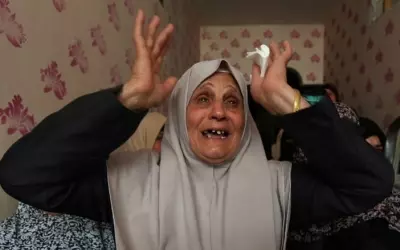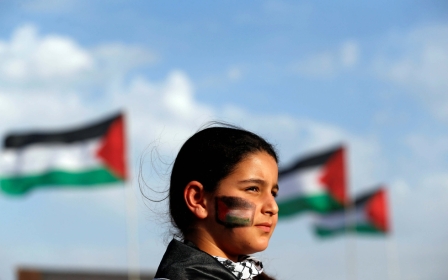Ancient plants: Reflections on Palestinian life from the Galilee mountains

I always like my beer on the bitter side. Recently, I discovered the wild variety of plant behind the delicate taste.
On the afternoon of our 79th (combined average) birthday, my wife and I took a lengthy hike in the Galilee mountains that frame Arrabeh. We used to walk the same mountain paths, carrying our two children on our backs, to visit our friends, the two monks who chose the highest peak in our range to recreate early monastic life in Palestine.
This was before the Ariel Sharon-led assault on the Galilee, with all the Jewish-only, mountain-top settlements justified as being needed to protect our land from us.
My wife and I gingerly supported our sagging frames with a pair of walking sticks each. We met our minimum of 10,000 steps on the Fitbit my wife wears. She is a stickler for precision on matters that I usually guess at.
That also was the case when it came to identifying the native greenery on the side of the dirt path: trees, bushes, flowers and grasses, both edible and poisonous.
At one point, she called my attention to a thin, wheat-like stalk with a pretty, dangling, heavy head, which she identified as wild hops. I picked one and carefully wrapped it in a paper towel to show to my jeweller grandnephew, so that he could recreate it in gold or silver as an earring or pendant.
The next day, I recalled our hike while reading a news item stating that a centuries-old mosque in Safed, the birthplace of Palestinian President Mahmoud Abbas, had been converted into a bar and wedding hall. According to al-Quds al-Arabi, the al-Ahmar Mosque has been repurposed several times since 1948 - first into a Jewish school, then an election campaigns centre, then a clothing shop and now a bar and events hall.
This was not as shocking to me as it might have been to other readers. For years, when friends have visited from abroad, I've often taken them to one of my favourite sites: Ein Hod's old mosque. On the way there, I usually explained the sociocultural miracle that the Romanian new immigrant Dadaist artist, Marcel Janco, and his followers had wrought.
Parched palate
In the 1950s, they had saved the stone homes of the centuries-old Palestinian village of Ein Hawd from demolition in order to form an art colony. In the process, the name of the village was changed from the Arabic Ein Hawd (meaning "Spring of the Trough") to the Hebrew Ein Hod (meaning "Spring of Grace").
They offered some of the village's original Palestinian residents - descendants of the Abu al-Hija clan who had moved to their olive fields and would eventually establish the new Ein Hawd there - a level of sustenance as guards, gardeners and housekeepers in their own original homes, repurposed as art galleries.
I usually alluded to the majority of the Abu al-Hijas, who became refugees in Jenin, and who provided the plot for Mornings in Jenin, the novel that launched my friend Susan Abulhawa as a leading Palestinian fiction writer.
Others have not been as lucky. Witness the unrecognised Bedouin village of al-Araqib, which has been demolished and rebuilt close to 150 times
By this point in my tour-guiding, I usually suffer from a parched palate because of the emotional impact of the narrative - and, even more, because, as a writer, I have for years been scrabbling after Abulhawa's level of literary achievement.
You can imagine how thirst-quenching an ice-cold beer is. After that, we usually rush back to our bus at the adjoining parking plot, the asphalt-topped former village cemetery, and head up to the alternative Ein Hawd that led the struggle for scores of unrecognised Palestinian villages in Israel. Like a dozen or so other such villages, this one has finally gained recognition.
Jewish nation's deed
Others have not been as lucky. Witness the unrecognised Bedouin village of al-Araqib, which has been demolished and rebuilt close to 150 times. When the court prohibits its chief, Sheikh Sayyah al-Turi, from entering the village, he seeks shelter in its cemetery.
No wonder his wife and their son served jail terms as well. They lack the necessary empathy with Holocaust descendants to move out of the way, enabling Jewish settlers to build a residential paradise in their place and make the desert bloom. The logic of involved government officials, including Supreme Court judges, is impeccable: the focus must be on Jewish settlers reclaiming their homeland.
God, my throat is parched again. Think of all the bars that would have studded the country, had Israel been more careful. In the aftermath of the Nakba, in the 1950s alone, the state demolished 1,200 mosques, with their adjacent cemeteries, no doubt.
Israel's representative at the UN has shown the Security Council the Jewish nation's "deed" to the entire Promised Land.
The same deed promised the Jewish nation enough Palestinians to serve as "choppers of wood and drawers of water". But now we have imported Chinese, Thai and Sri Lankan manual labourers, obviating the need for Bedouin servants in this or the next life.
That is why their cemetery will likely go with them to who-knows-where. To hell, if need be.
The views expressed in this article belong to the author and do not necessarily reflect the editorial policy of Middle East Eye.
Middle East Eye propose une couverture et une analyse indépendantes et incomparables du Moyen-Orient, de l’Afrique du Nord et d’autres régions du monde. Pour en savoir plus sur la reprise de ce contenu et les frais qui s’appliquent, veuillez remplir ce formulaire [en anglais]. Pour en savoir plus sur MEE, cliquez ici [en anglais].







